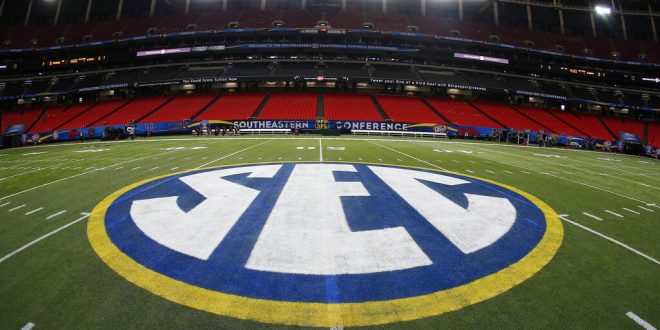The landscape of college football resembles a deck of cards, different colors and suits representing resources, locations, and talent across the board. Like any good card game, a certain suit can always trump the others. The same goes for the powerhouses of college football. The elites who have consistently found themselves at the top of the College Football Playoffs including Alabama, Ohio State, Clemson, Oklahoma and more do have one thing in common- superb recruiting. In order to go toe-to-toe with the best in the country, a team must have some of the nation’s best players to take the field.
ESPN’s Tom Luginbill is one of the nation’s most respected analysts on all things college football. He recognizes that recruiting is a huge element of the college football landscape.
“Not everyone is playing with the same deck of cards, not everyone has the same resources, funding, fanbase, boosters and alumni,” Luginbill said.
Ultimately, the foundation of college football is built on recruiting and flows directly up all the way to championships. This has resulted in gaps in talent and a lack of a diversity of the nation’s top teams, year in and year out. “That isn’t changing, there is always going to be that gap,” he said.
After an un-expected year due to the global pandemic, teams across the country have taken on a totally new look. Dead recruiting periods, extra years of eligibility, plus the transfer portal all have added new elements for the upcoming season that will lead to ramifications for years to come.
Extra Year of Eligibility:
First things first, due to COVID-19 the NCAA has granted athletes an extra year of eligibility. In theory, this decision by the NCAA seems like the only fair thing to do given the uncontrollable and heartbreaking opportunities that were stripped away from athletes across the country. But, diving deeper into the number of scholarships and roster spots available quickly turns into a tailspin for all involved.
“The NCAA decided to give everyone an extra year, and then they dump it on the laps of the schools and programs and said hey, you figure it out,” Luginbill said. “They didn’t give them any rules or guidelines.”
The ramifications of COVID-19 is two-fold, first with the extra year of eligibility and then add in the transfer portal, sufficiently causing chaos for recruiting departments.
Transfer Portal:
First established in 2019, the transfer portal has created an entirely new recruiting avenue that can significantly change a locker room from year to year. Programs like Florida, Oklahoma and even LSU with Joe Burrow have been the biggest benefactors. But, the transfer portal this year especially has blurred the lines of available scholarship opportunities following this upcoming season.
“When a team signs a prospect he is labeled as an initial counter, he counts against that 85, you can have on the roster,” Luginbill said. ” If that player leaves the program and jumps into the transfer portal, you do not get that initial counter back, it goes with him. Now you have to figure out in order to replace him you will have to use another initial counter and by the way, you are now way over the 85 scholarships due to the extra year of eligibility.”
For now, there is an influx of talent in the portal, but the lasting effects of this pandemic will still be ever-present when teams have to compress back to 85 scholarship spots following this next season.
Even more concerning for both teams and players is the amount of talent in the portal currently. Even with the roster limitations temporarily lifted, there is more players than positions for them to land. According to research done by Luginbill and company at ESPN as of Feb. 1, there were over 1,800 kids in the transfer portal, only less than 10% will be able to sign scholarships. There is simply nowhere for them to go.
In addition to current division one players being affected, junior college players are being affected even more negatively. Last year during the February signing day, there were around 300 junior college prospects signing, this year there were only a little over 100. “Clearly the resources are going towards high school students and towards the transfer portal,” Luginbill said.
“For now, there is a lot of gray area in all of this, and it is only going to get muddier and muddier before it gets clearer,” he said.
College Football Playoffs:
With all of this in mind, how will the college football playoffs be affected? Will pickups like Arik Gilbert formerly with LSU now with Florida or the three former Tennessee Volunteer players in Key Lawrence, Wayna Morris, and Eric Gray now joining the Sooners change the way the season unfolds. With these most recent transfer portal landings, could these difference-makers take their new teams to the postseason? As it stands now, it doesn’t seem the committee is budging on the structure and number of the playoffs.
“We have had a lot of meetings as a group over here at ESPN with Bill Hancock and the Committee talking about this and to this point they have dug their heels in, “Luginbill said.” Right now they are under a tremendous amount of pressure and they have never caved, or at least not yet, but I think the pressure is going to become greater and greater.”
Luginbill also noted that he doesn’t think it would be a big jump if it were to happen, saying he thinks the playoff would stick to six at first if any changes were to occur.
 ESPN 98.1 FM / 850 AM WRUF ESPN 98.1 FM / 850 AM WRUF
ESPN 98.1 FM / 850 AM WRUF ESPN 98.1 FM / 850 AM WRUF




